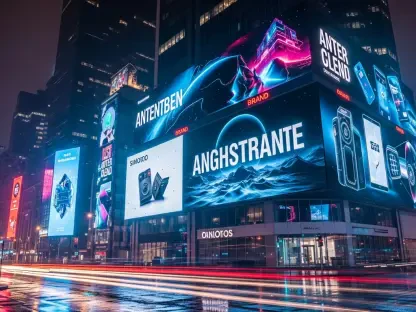In the rapidly evolving digital marketing arena, the decision to gate content—placing it behind forms, paywalls, or other barriers—or to make it freely accessible has become a complex puzzle with high stakes, especially as AI-driven search technologies reshape user behavior. The emergence of tools like Google’s AI Overviews, Microsoft Copilot, and ChatGPT has fundamentally altered how users discover and trust brands, turning visibility into a non-negotiable asset. No longer can marketers rely on traditional tactics where organic search rankings guaranteed traffic, even for hidden content. Today, AI systems dictate discoverability by synthesizing answers directly, often bypassing gated material entirely. This shift challenges the old balance between capturing leads and maximizing reach, pushing marketers to rethink strategies to ensure their brand remains relevant. As AI shapes the way information is accessed and prioritized, the question of what to hide and what to show takes on new urgency. This article delves into the evolving landscape of content gating, exploring how marketers can adapt to maintain authority and engagement in an era where being seen by both humans and algorithms is paramount. The focus is on crafting a nuanced approach that aligns with modern search realities while still meeting business goals.
The Shifting Landscape of Content Gating
The debate over gating content has historically centered on a straightforward trade-off: ungated material draws a larger audience but yields fewer leads, whereas gated content narrows the audience yet targets more committed prospects. For years, the assumption was that users would navigate barriers if the value behind them was compelling enough, and organic search would still drive visibility. However, this perspective fails to account for the transformative impact of AI on search behavior. Unlike traditional engines that prioritized links to full pages, AI tools summarize content directly, pulling from what is openly available. This means that hidden content often gets overlooked, no matter its quality, as algorithms favor what they can easily parse. Marketers now face a reality where the old rules no longer apply, and clinging to outdated strategies risks irrelevance in a space where competitors adapt swiftly.
This shift underscores a critical need to reassess how gating decisions affect a brand’s digital footprint. AI search systems don’t just influence traffic; they shape perceptions of authority and trust by deciding which sources to cite in their concise answer layers. If content is locked away, it’s not just missing from search results—it’s absent from the conversation entirely. This can cede ground to rivals who strategically expose key insights, even if their offerings are less robust. The challenge lies in recognizing that visibility has become a prerequisite for success, forcing a pivot from a binary gating mindset to one that prioritizes strategic exposure. Marketers must now navigate this terrain with an eye toward balancing immediate lead generation goals against the long-term necessity of being recognized by AI as a credible source.
AI’s Role in Redefining Content Visibility
AI-driven search technologies operate on a fundamentally different principle than their predecessors, transforming how content is discovered and valued. Rather than indexing entire web pages and directing users to specific URLs, these systems extract and synthesize information sentence by sentence, delivering direct answers in a summarized format. This “answer layer” prioritizes relevance and clarity, but it comes with a catch: if content is concealed behind a form, paywall, or other barrier, AI models typically cannot access or reference it. The result is a stark invisibility that sidelines even the most valuable insights, leaving brands out of critical user interactions. This dynamic poses a significant risk, as competitors who make summaries or key points accessible often emerge as the go-to authority in AI-generated responses, regardless of depth.
The implications of this for content strategy are profound, as AI rewards what is visible and trustworthy over what is merely comprehensive. Hidden material, no matter how expertly crafted, fails to register in the algorithms that now mediate much of online discovery. Marketers must grapple with the reality that being unseen by AI equates to being unseen by a growing segment of users who rely on these tools for quick, reliable information. This necessitates a strategic rethink, where ensuring a presence in AI search results becomes a foundational step before any gating tactics are applied. The focus shifts to crafting content that algorithms can parse and cite, establishing a brand’s relevance in the digital ecosystem. Only then can deeper engagement strategies, such as capturing leads through selective barriers, be effectively layered on top.
Crafting a Tiered Gating Strategy for Balance
Navigating the complexities of content gating in an AI-dominated environment calls for a nuanced, tiered framework that moves beyond the simplistic choice of hiding or revealing everything. This approach categorizes content into three distinct layers—always ungated, conditionally gated, and never gated—each designed to serve specific purposes in maintaining visibility while still supporting lead generation. By aligning gating decisions with the dual needs of AI discoverability and business objectives, marketers can create a balanced strategy that mitigates the risks of invisibility. This layered method offers a practical roadmap for ensuring a brand remains both seen and trusted in a competitive digital space.
The “always ungated” layer, often referred to as the “Understand Me” category, encompasses content vital for establishing brand identity and credibility. This includes summaries, FAQs, pricing information, and author credentials—elements that both human users and AI systems rely on to gauge trustworthiness. Gating such material can severely limit a brand’s recognition in AI citations and weaken its digital knowledge graph, diminishing overall authority. Keeping these assets openly accessible ensures they are parsed by algorithms, reinforcing a foundation of trust and relevance. This layer prioritizes long-term visibility over short-term lead capture, recognizing that without a strong initial presence, deeper engagement becomes nearly impossible to achieve.
Content falling into the “conditionally gated” layer, or the “Earn the Right” category, includes high-value resources like research reports, detailed guides, and case studies that warrant selective access. A teaser strategy proves effective here: key takeaways or abstracts remain visible to secure AI inclusion and establish thought leadership, while full access to in-depth material requires a form submission or similar barrier. This hybrid tactic balances the need for visibility with the goal of capturing quality leads, ensuring the brand is cited in AI responses without giving away every asset for free. It’s a calculated compromise that allows marketers to build authority while still driving meaningful user engagement through targeted gating.
Finally, the “never gated” layer, known as the “Credibility” category, covers essentials that must always remain accessible, such as basic product descriptions and pricing details. Hiding these undermines critical E-E-A-T signals—Experience, Expertise, Authoritativeness, and Trustworthiness—that AI and users alike depend on to assess reliability. When such information is locked away, it often drives both algorithms and audiences to competitors or less accurate third-party sources, eroding a brand’s reputation. Maintaining open access to these fundamentals ensures a brand is perceived as transparent and dependable, a non-negotiable factor in sustaining digital trust. This layer serves as a reminder that some content must prioritize accessibility over any potential revenue or lead capture benefits.
Addressing Hidden Obstacles to AI Access
Beyond deliberate gating choices, marketers must also contend with barriers like paywalls and unintentional “soft gates” that obstruct AI visibility in subtle yet impactful ways. Hard paywalls, often implemented as a revenue stream, typically exclude content from AI search unless accompanied by visible snippets or secured through licensing agreements with major AI providers. For most brands, unlike established publishers with significant clout, this translates to near-total obscurity in algorithm-driven results. The trade-off between subscription income and digital reach becomes a critical consideration, often requiring creative solutions like offering accessible summaries alongside premium access to maintain a presence in AI answer layers.
Equally problematic are soft gates—barriers that seem minor to human users but are insurmountable for AI systems. Examples include PDFs tucked behind pop-up modals, content hidden under “read more” toggles, or inline lead generation overlays that require interaction to reveal information. Since AI models don’t replicate human behaviors like clicking or expanding sections, such content remains effectively gated, invisible to the algorithms that power modern search. Addressing these issues involves ensuring key information is embedded in rendered HTML at page load, free from interactive barriers. By identifying and eliminating these accidental obstacles, or at least exposing critical points openly, brands can prevent unintended exclusion from AI-driven discovery, preserving their relevance in an increasingly automated search landscape.
Visibility as the Foundation for Future Success
Reflecting on the evolution of content gating, it becomes evident that AI-driven search has reshaped the digital marketing playbook in profound ways. Marketers have adapted by recognizing that visibility is no longer just a means to an end but the cornerstone of sustained relevance. Strategies have pivoted to prioritize what algorithms can see and cite, ensuring brands are part of the conversation before deeper engagement tactics are deployed. This marks a departure from past assumptions that users would always navigate barriers for valuable content, acknowledging instead that AI systems hold the gatekeeping power in modern discovery.
Looking ahead, the actionable path forward lies in embracing a visibility-first mindset with strategic precision. Marketers should audit existing content to identify what must remain ungated for AI recognition, while implementing teaser approaches for high-value assets to balance lead capture with exposure. Regular assessments of soft gates and paywall impacts can further refine this approach, ensuring no accidental barriers hinder discoverability. By mapping gating decisions to outcomes like trust, authority, and engagement, brands can build a robust framework that thrives in an AI-driven ecosystem. The focus must remain on establishing a strong digital presence as the foundation, from which all other goals—lead generation, revenue, and loyalty—can grow.








